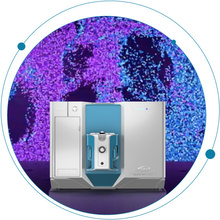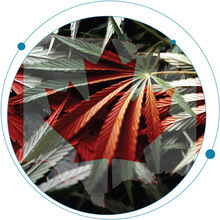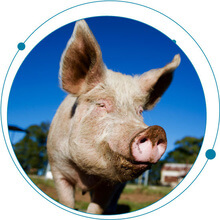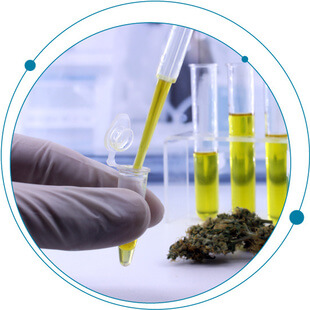To set up a SCIEX high flow source for microflow LC (Turbo V ion source, DuoSpray source or IonDrive Turbo V ion source), first you must replace the wider bore electrodes with more narrow bore hybrid electrodes. Note with the OptiFlow Turbo V ion sources, there are...
Tags
Questions and answers to help improve your mycotoxin analysis
During a recent webinar I shared method details for mycotoxin analysis on the SCIEX 7500 system. In this blog i will share the Q&A for the submitted questions that we did not have chance to answer during the live webinar.
Optimized rolling collision energy curves for IDA and SWATH DIA for peptides
During data dependent acquisition (DDA or IDA) or SWATH acquisition, the collision energy can be automatically adjusted according to the mass/charge and charge of the peptide. This dependency has been well characterized on our QTOF systems. By selecting rolling...

Back to the new basics: Part 1 | Making the leap from GC-MS to LC-MS
Producing accurate results quickly in a demanding environment is no easy feat for analytical scientists. What’s more, many of us are constantly questioning ourselves—I certainly am—about whether we are employing the best technique for the analysis at hand.
It’s an overwhelming thought, considering the wide range of tools that are available to choose from, each of which offers varying levels of capacity, sensitivity, selectivity, specificity and cost. How do you meet the unique needs of your organization without breaking the bank? I get it, and I’m not here to convince you it’s easy. My aim is to guide you through the process to help you make the right decision for you.
MRM method transfer from a SCIEX Triple Quad or QTRAP 6500+ system to the SCIEX 7500 system
General recommendations when beginning method development Objective: The purpose of this document is to provide a quick reference for transferring MRM-based quantification methods from a SCIEX Triple Quad or QTRAP 6500+ system to a SCIEX 7500 system. While the best...
Adapting a SCIEX high flow source for microflow LC
To set up a SCIEX high flow source for microflow LC (Turbo V ion source, DuoSpray source or IonDrive Turbo V ion source), first you must replace the wider bore electrodes with more narrow bore hybrid electrodes. Note with the OptiFlow Turbo V ion sources, there are...

Identifying the unknown PFAS profile in firefighting foams/AFFF
According to a recent study from Harvard University, the US EPA, and NIEHS, traditional targeted analysis techniques poorly characterize the PFAS composition of contemporary PFAS-based firefighting foams, know as aqueous film-forming foams (AFFF). Using the EPA 533 PFAS drinking water method for the analyte list, the researchers found that targeted mass spectrometry methods accounted for <1% of organic fluorine content. This is important because it demonstrates that targeted analysis methods miss nearly all the PFAS compounds in modern AFFF mixtures, thus underestimating the risk to human health and the environment.
sMRM Concurrency Calculator
This excel sheet allows you to quickly estimate the MRM concurrency and approximate dwell time for your Scheduled MRM Algorithm acquisition method. Paste your MRM method with retention times into the input tab then calculate the Excel workbook. Plots will update to...
The risky business of aflatoxins in milk
If you’re in the dairy or food testing business, you know the threat aflatoxins pose. Aflatoxins are a type of mycotoxin produced by Aspergillus parasiticus, aspergillus flavus , and rarely aspergillus nomius.1 These are likely the most extensively researched group of mycotoxins because of their adverse health effects.2 What’s more, they are widely found in a variety of crops, namely maize, tree nuts, and spices. Believed to be primarily caused by rising temperatures and humidity, these naturally occurring fungi grow on crops in the field, or during storage of feed and raw materials, where they can potentially produce toxins that enter the food chain.

Breaking down the SCIEX Triple Quad™ 7500 LC-MS/MS System – QTRAP® Ready
Sensitivity and robustness carry different meanings in the world of mass spectrometry. Generally, sensitivity refers to an instrument’s ability to achieve lower limits of detection (LOD). Robustness, on the other hand, refers to an instrument’s ability to consistently...
The honey sting
As a consumer it’s hard for me not to feel inundated with claims that our food is “all-natural” or “chemical-free” or that we should buy certain “superfoods” for their health benefits. We read labels and trust that the product we are buying is what we are truly...
Trends shaping global environmental analytical testing
The only certainty in a changing environmental landscape Despite a 38-fold increase in environmental laws put in place around the world since 1972, the future of our planet is under the spotlight like never before. Mitigating climate change has arrived as our world's...

Mass spectrometry as a forensic science tool in 2020
There’s no doubt about it: forensics is at the front line of the criminal justice system. It’s where analytical chemistry has the power to fight crimes. It’s fascinating! But what excites me is how quickly things change and the speed of innovation. Just think about...
Microflow for metabolite ID: a win all around
Over the last several years there has been a slow and steady progression within the LC-MS community to move traditional high-flow applications to lower flow rates. In particular, moving into the microflow regime has proven to be a simple adjustment in methodology that...

A year of cannabis in Canada. Where are we and what’s next?
It’s been a momentous year for the cannabis industry in Canada. Not only did the country legalize cannabis with the Canadian cannabis law in October 2018, but it has also taken a giant leap in setting up a multi-billion dollar market from scratch. The progress made...

Take 5 with SCIEX Global Technical Marketing’s Pierre Negri
With the rise of Novel Psychoactive Substances (NPS), or designer drugs, in the past decade, forensic toxicologists are being tested like never before. It seems like as soon as one analog is identified, another is synthesized. These new chemicals share structures with...
When is a triple quadrupole not a triple quadrupole?
Answer: When it’s a QTRAP® In today’s modern and frenzied analytical laboratories, triple quadrupole mass spectrometers (MS) are the ‘workhorse,’ frontline instrument for carrying out quantitative assays from drug discovery to food safety. To get the best selectivity...

Turbo charging your LC-MS/MS analysis
Would you like to take your LC-MS/MS analysis from 0 to 3 mL/min without the complexity of changing probes or splitting the LC flow? Then take a look into the Turbo V ion source from SCIEX. Introduced more than 15 years ago, the Turbo V ion source continues to be a...

Separation anxiety: Choosing the best approach to quantify the lipidome
Front-End Solutions for Lipid AnalysisWhich method should you choose? Lipids are a diverse group of compounds that serve many purposes. They are the basis for key biological entities including cell membranes, hormones, and lipoproteins and are involved in a variety...

Your 3 most googled queries about cannabis testing answered
I did some digging on Google and decided to help answer the top 3 most searched queries about cannabis testing methods and technology, for both marijuana and hemp. 1. What equipment should I use to test my cannabis and hemp samples for mycotoxins,...

Boar taint isn’t so simple
The title says it all. Boar taint is a complex subject. For some, it’s not an issue. Others argue that it’s one of the biggest challenges to pork quality. It’s a very subjective response. In her blog, Dr. Laura Hancox illustrates the striking difference between the...

A beginner’s instrumentation guide to cannabis analysis
One question I get asked a lot when it comes to cannabis, specifically regarding marijuana and hemp analysis, is: There are so many techniques to choose from, how do I know which one is best? I can’t emphasize enough that the Cannabis sativa plant has a complex...

Worth the Journey – From Immunoassay to LC-MS/MS Adoption
The journey to mass spectrometry (LC-MS/MS) adoption from immunoassay can be complicated, but certainly rewarding. While immunoassay has been considered the default methodology for decades, they can be susceptible to interferences and cross-reactivity, especially for...

Journey to the Center of the Vape – Part 1
The safety of vaping has recently become a topic of concern. The public wants answers about the safety of these products. Health authorities are scrambling to find the cause of the mysterious vaping illness that has been seen in hundreds of cases across the U.S., and...

Keep Those Interactions Intact and Analyze the True Nature of Your Protein Compounds
There’s no doubt that mass spectrometry has emerged as an essential technique for drug discovery and development. But the denaturing conditions of conventional LC-MS will typically break apart any non-covalent interactions that exist in solution – even though there is...

Top 5 Analytical Challenges for Pesticides in Cannabis
Now that cannabis is legalized in a majority of the United States and Canada, new regulations to help protect consumers lead us to an important question: What are they getting? Here, we'll help provide the answer. Image source: Shayanne Gal/Business Insider Some of...

To Switch or Not to Switch? That is the Question.
Why Polarity Switching Matters The BasicsIn today’s busy analytical laboratories, productivity and high sample throughput are constant demands. More samples need to be analyzed in a shorter timeframe. Laboratories must work to use equipment at its maximum capacity,...

Improving precision
Factors that affect the reproducibility of your assay As scientists, we know our experiments must be reproducible. Without it, there is always doubt as to whether our data interpretations and conclusions are truly sound. With LC-MS/MS quantitative methods, high...

30 years of LC-MS/MS innovation continues
In 1989, the first commercial, dedicated Atmospheric Pressure Ionisation (API) tandem quadrupole mass spectrometry system was launched at the Pittsburgh Conference (PittCon) in Atlanta, Georgia (GA), USA. The API III, as it was called, was introduced to the analytical...

Drugs of Abuse Analysis: How LC-MS/MS Reduced Run Times by 66% and Tripled Throughput
Elevate Performance in Your Forensic Toxicology LabYou only need to skim through the United Nations World Drug Report 2018 to see that drug abuse is escalating. Associated with numerous medical, social, and legal problems, it comes as no surprise that ‘drugs of abuse’...

Same Pesticides, Same Risks, Different Standards
Should we be worried about our health because our produce contains pesticides? The answer very much depends on where in the world you live–or where your food comes from. When it comes to protecting people from harmful pesticide residues in food, standards around the...



 Contact Support
Contact Support